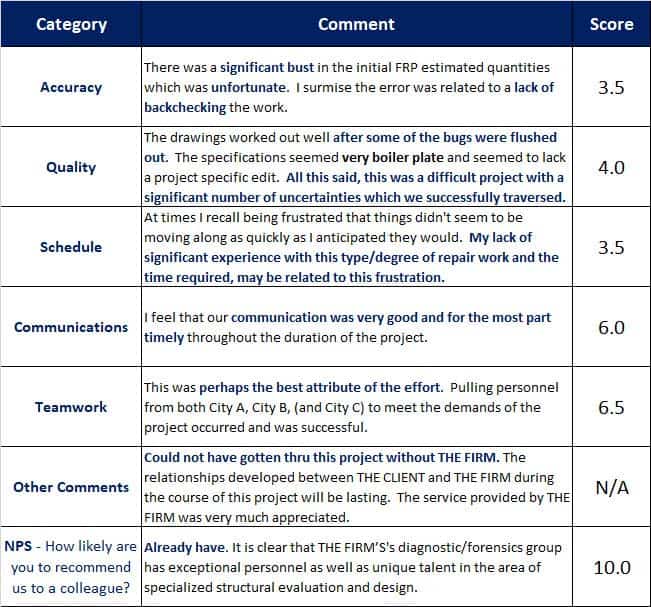From time to time, Client Savvy selects a client, takes a chunk of their recent data and conducts a linguistic analysis to give them deeper insight into what their clients are saying. We believe that as important as numerical analysis is to understanding client perceptions, linguistic analysis is useful because it focuses on more of the human elements and emotional sentiment that come through in the client comments that accompany scores.
As I worked through one of our clients’ data recently, I came upon a wonderful story that serves as a useful case study regarding why it is important to know what is going on “behind” the scores. At the very least, it is a good reminder that we should constantly be curious about the experiences and emotions that motivate and impact our clients’ choices.
This story focuses on one individual who responded to a feedback request from one of our clients. This individual’s data immediately stood out because in addition to providing feedback scores, he included extensive comments. To give you a frame of reference, most respondents will leave a comment for one or two questions. It is rare to see someone put that kind of time into an entire survey.
Another reason this person’s data was interesting was that his scores were all over the map. The Client Feedback Tool offers respondents a 1- to 7-point scale where 7 is Exceptional and 4 is Met Expectations. Of the 5 questions in this survey, he gave two scores under 4, one at exactly 4, and two scores above 6. He also provided a perfect 10 for the Net Promoter Score question. I was curious to find out how such a mix of feelings still resulted in a strong promoter.
This chart shows the comments and scores for each question category. THE FIRM refers to the Firm doing the work (and sending out the feedback request), while THE CLIENT refers to this respondent and/or his organization. Bolded sections of the comments highlight specific language that is key to understanding this individual’s experience.
Accuracy. The word “unfortunate” is bolded in the comment related to Accuracy. Unfortunate implies something going wrong, but it also does not imply blame. Something that is “unfortunate” is a happenstance, a regrettable situation that needn’t have occurred, but for which no one is necessarily at fault. Even though the respondent here clearly states he believes someone didn’t do the necessary backchecking, he does not allot the blame onto anyone. While the score is low, the emotions are not as intense as might be expected. This reflects ambiguity – in the world of linguistics, ambiguity describes a multiplicity of sentiments and messages contained within the same text or utterance. Sometimes this can be intentional or even playful (like double entendre) but in cases like this one, it generally belies a complexity of emotions or a difficulty in expression.
Quality. Once again there are some serious issues being raised (although the score given is Met Expectations). On the one hand, there were “bugs” that needed to be “flushed out” and concerns about work that was “boiler plate.” This is certainly not something anyone wants to hear from their client. But then this respondent provides a major caveat. There is a recognition that this was a “difficult project with a significant number of uncertainties all of which we successfully traversed.” Therefore, this score reflects the same ambiguity that was present in the Accuracy comment.
Schedule. This pattern of ambiguity continues to the question regarding Schedule. The respondent “recall(s) being frustrated” by the slow pace of the schedule, but then readily admits his own “lack of significant experience with this type/degree of work” might be a possible contributor to that frustration.
The final two categories, Communication and Teamwork, were mostly positive, as would be expected when seeing scores at 6 and above. Interestingly, the respondent still uses passive phrasing – often seen in negative comments but less common in positive ones. When he says that gathering a team from multiple locations “occurred and was successful,” he does not attribute that success to any one person or party. The fact that he spells this out in such stark terms most likely is an indicator that when he was informed of this plan to create cross-geographical team, he was doubtful that it would work. The mere fact that it “occurred,” therefore, is noteworthy.
His final comments, in response to the Other Comments question, say that this client “could not have gotten thru (sic) this project without THE FIRM.” This comment has a lot to unpack. First, let’s explore the phrase “could not have gotten through ___”; this is a phrase that we use when we talk about a truly challenging experience, something arduous and demanding and maybe even life-threatening. Of course, we can presume this man’s life was never in danger, but nevertheless he uses this type of language to describe a project at work. This more emotional form of expression is a departure from the measured language used in the rest of the comments. It is also worth noting that the emphasis of this comment is on the relationships that were built and the support this individual received during the project – the support he received not as a client, but as a person. The client uses language that indicates this project was daunting and perhaps even unpleasant. That idea, together with the ambiguity present in the comments related to the first three questions, makes it clear that, for whatever the reason, this individual was dealing with a not insignificant amount of anxiety throughout this project’s lifecycle. His feedback reflects his emotional state during the project
, as well as the way THE FIRM either helped or hindered him. Assuming THE FIRM asked him for feedback throughout the project (and if they didn’t this is a great case study for why you should), what could THE FIRM have done to either anticipate or alleviate the anxiety related to scheduling when the client was feeling it? How could THE FIRM have bolstered his confidence in what they were doing at the time he was anxious about the project and his own inexperience with problems of that
magnitude?
When I brought this analysis back to THE FIRM, I saw some lightbulbs go off in the room. One member of THE FIRM’s team looked at me and said, “Well yeah – this project was for our diagnostic/forensic group. You only end up working with those guys if you have a project that goes really wrong.”
As it turns out, THE FIRM was treating all their clients the same, even though their clients’ backgrounds and experiences may vary widely. We discussed the situations in which clients find themselves working with THE FIRM and talked through the scenarios that might come up. We also talked about the other external factors, like emotions or deadlines, that might contribute to those situations. Through getting a better understanding of the emotions surrounding this feedback, THE FIRM came to realize there might be better ways for the diagnostic/forensic division of the company to approach their clients. Because of the nature of the projects this division works on, they might decide to provide clients with extra support in the form of clearer expectations and additional empathy for whatever the circumstances were that led them to need this kind of help. By redirecting this conversation away from the numbers and instead to the experience underneath them, the group came to realize there were a lot of opportunities for the firm and their clients.
This individual responded to the NPS questions saying that he “already had” recommended THE FIRM to other people. Of course, my final recommendation to the group was to reach out and find out who he had spoken with and ask for that introduction. Using linguistic analysis as part of this firm’s feedback review enabled them to take a conversation about low scores and turn it into new opportunities for the firm, both in terms of new work and in delivering client experience. All this in about 20 minutes of conversation.
Numbers are critical to the evaluation process. They can, however, tell only one slice of the story and provide one layer of information. Numbers are nothing more than an indicator of where problems or opportunities might be and are not meant to be viewed in the sharp contrast of “good” or “bad,” although that is certainly tempting. As we work with our clients, we encourage them to use the numbers they get and their own innate curiosity. Look at the score, compare it to the comment and ask: “I wonder why they said that?” Going one layer deeper, a whole world of stories and opportunities opens up.
Download a SAMPLE report to see how Linguistic Analysis helps you understand what your clients are really saying.







